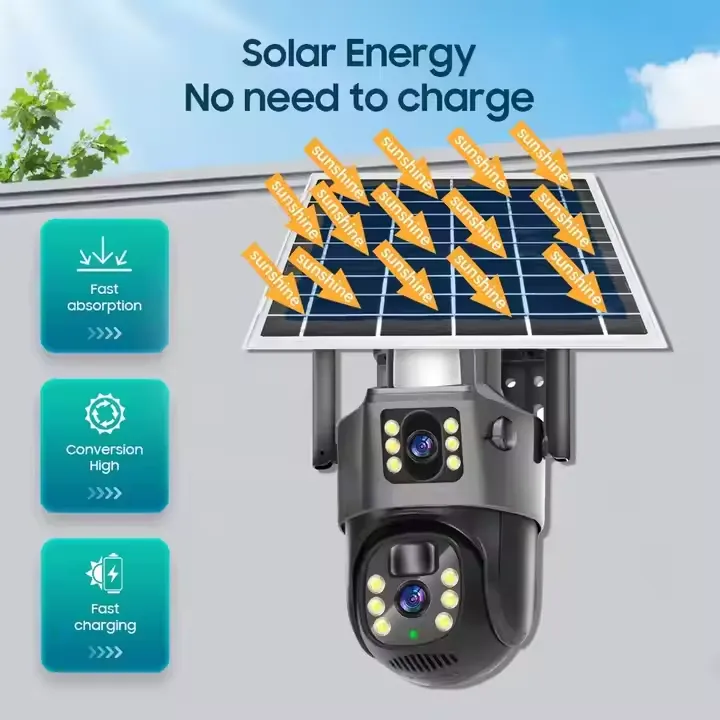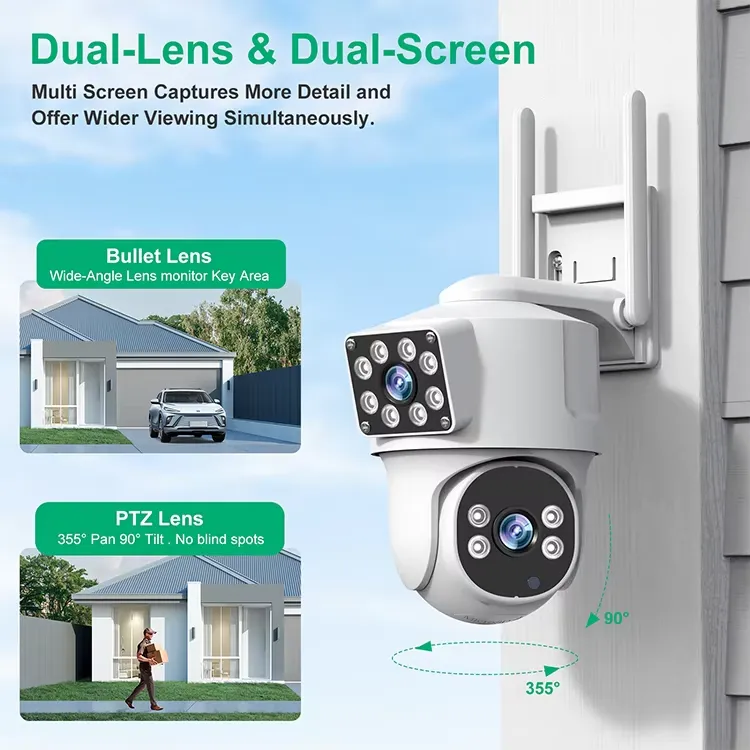ワイヤレスソーラーセキュリティカメラは、持続可能な技術と家庭の保護の完璧な融合を表し、従来の監視システムに代わる環境に優しい選択肢を提供します。これらの革新的なデバイスは、信頼性の高いセキュリティ監視に電力を供給するために太陽エネルギーを利用し、コンセントや定期的な電池交換の必要性を排除します。機能性に妥協することなく、より環境に優しいソリューションを求める家庭が増えている中、太陽光発電セキュリティカメラは傑出した選択肢として登場しました。消費電力が大きい、複雑な配線が必要、電気代がかかるといった従来のカメラの主な欠点に対処しながら、信頼性の高い保護を提供します。
環境に優しいワイヤレス・ソーラー・セキュリティ・カメラとは?
ワイヤレス・ソーラー・セキュリティ・カメラによる持続可能な家の安全確保
今日の環境意識の高い世界では、自宅の安全を確保するために地球を犠牲にすべきではありません。ワイヤレスソーラー防犯カメラは、強固なセキュリティと環境への責任を両立させる独創的なソリューションです。
10年以上の経験を持つセキュリティーシステムの専門家として、私はどのようにセキュリティーシステムが機能しているかを目の当たりにしてきた。 ワイヤレスソーラー防犯カメラ が家庭の保護に革命を起こす。これらの機器は、高効率のソーラーパネルを通じて太陽のエネルギーを利用し、太陽光を電力に変換して内蔵のリチウムイオン電池に蓄える。
環境への影響は非常に大きい。従来の有線カメラは4~15ワットの電力を継続的に消費し、カメラ1台あたり年間35~131kWhを消費しています。のような太陽光発電に切り替えることで、このエネルギー需要をなくすことができます。 4Gソーラーカメラ.
しかし、エコの恩恵は単なる省エネにとどまらない。これらのシステムの持続可能性機能は非常に印象的だ:
| エコ特集 | 環境への恩恵 |
|---|---|
| バッテリー効率 | 直射日光の当たらない場所で5~7日間使用可能 |
| 製造材料 | 環境に配慮した生産 |
| 5年間のCO₂削減量 | 124~465kg/カメラ |
について 4GソーラーPTZカメラ のモデルは、省電力性を損なわないパン・チルト・ズーム機能により、この効率性をさらに高めています。これらの先進的なユニットは、完全にオフグリッドで動作しながら、優れた監視範囲を維持します。
長時間の曇天時の信頼性を心配される方には、最新の 24時間録画4G AOVソーラーカメラ は、直射日光を浴びずに最大1週間機能し続けるのに十分な電力を蓄えることができる。私はこれらのシステムをさまざまな気候でテストしてきたが、天候があまり良くない状況でも驚くほど回復力がある。
ソーラーセキュリティカメラは、一般的な5年間の寿命で約175~655kWhの送電網の電力消費を防ぐことで、ご家庭の二酸化炭素排出量の削減に大きく貢献します。ソーラーセキュリティカメラは、個人的なセキュリティニーズと環境に対する責任、つまり地球に負担をかけない保護が見事に調和した製品なのです。
ソーラー警備でどれだけ節約できるか?
ソーラー・セキュリティについて、ドルやセントの話をしよう!
何百ものホームセキュリティのセットアップを分析した結果、私は次のような経済的な利点があることを発見した。 ワイヤレスソーラー防犯カメラ は本当に魅力的です。確かに、初期投資は若干高くなる(通常、ソーラーカメラ1台あたり$100~$300であるのに対し、従来の有線モデルは$50~$200)。
計算は非常に簡単です。電気代が不要になることで、カメラ1台あたり年間$5~$20の節約になります。画期的とは言えないかもしれませんが、4台のカメラシステムを数年にわたって使用すれば、かなりの節約になります。
ここからが本当の経済的メリットが明らかになるところだ:
| コスト係数 | 有線システム | 太陽系 |
|---|---|---|
| インストール | $100-$500(プロフェッショナル配線) | $0(DIYフレンドリー) |
| 年間電力量 | $20-$80(カメラ4台) | $0 |
| メンテナンス | 高い(故障箇所が多い) | より低い(部品点数が少ない) |
最近、私はクライアントのインストールを手伝った。 4Gソーラーカメラ システムは、配線コストだけで$400以上を削減しました!外部電源ケーブルが不要になったことで、コスト削減だけでなく、従来のシステムにありがちな脆弱性も解消されました。
について 4GソーラーPTZカメラ のモデルは特に寿命が長く、ソーラー・パネルは通常20年以上、カメラ・ユニット自体は5~7年は確実に機能します。このため、投資回収は通常わずか2~3年以内に行われます。
最大の価値を求める住宅所有者にとっては 24時間録画4G AOVソーラーカメラ は、継続的なコストをかけずに継続的な監視を実現します。あるクライアントは、以前の有線システムと比較して、5年間で$1,100ドル近く節約できたと計算しています。 ホームセキュリティ が特徴だ。
一般的なカメラ4台のソーラーシステムで、5年間で$600~$1,200の節約になると考えれば、経済的なイメージはさらに明確になります。これは単なるお小遣い稼ぎではなく、大幅な節約になると同時に、自宅のセキュリティ態勢を向上させ、環境への影響を減らすことができるのです。これこそ、賢い経済学と呼ぶにふさわしい!

どのような主要機能を探すべきか?
さて、経済的なメリットを理解したところで、実際に何が良いのかに焦点を当てよう。 ソーラーセキュリティカメラ.何十ものモデルをテストしてきた結果、すべてのカメラが同じように作られているわけではないことがわかった。
私の専門的な経験では、解決策を最優先事項として選択する。 ワイヤレスソーラー防犯カメラ.顔やナンバープレートをはっきり識別したいのであれば、1080p以下は決してお勧めしない。標準と高解像度の映像の違いは、有用な証拠と無駄なピクセルの違いになる。
| 必須機能 | 最低限の推奨事項 | プレミアム・オプション |
|---|---|---|
| 決議 | 1080p フルHD | 2Kまたは4KウルトラHD |
| ナイトビジョン | 30ft IRレンジ | カラーナイトビジョン、50フィート以上 |
| 天候評価 | IP65(防塵・防雨) | IP67(一時的な水没) |
| モーション検出 | 基本ゾーン | AI人間/車両検知 |
について 4Gソーラーカメラ 私がクライアントのためにインストールしたモデルは、24時間365日の保護のために譲れない機能である印象的な暗視機能を提供しています。標準的な赤外線LEDは30~50フィート先まで被写体を照らしますが、プレミアムモデルに搭載されている新しいカラー暗視技術は、日没後にさらに詳細な情報を提供します。
大きな物件をお持ちの方には、通常、次のような方法をお勧めする。 4GソーラーPTZカメラ パン・チルト・ズーム機能付き。これにより、より少ないカメラでより広い範囲をカバーし、必要に応じて特定の関心領域に焦点を合わせることができる。
ストレージ・ソリューションは、多くの人が思っている以上に重要である。24時間録画 4G AOVソーラーカメラ は、モーションクリップだけでなく、連続録画も可能ですが、そのためには十分なストレージ容量が必要です。ローカルストレージ(microSDカード)とクラウドベースのオプションのどちらがニーズやプライバシーの懸念に適しているかを検討してください。
AIを搭載した動体検知は、標準的なモーションセンサーに比べて誤報を最大95%減らすことができ、あらゆるお金を払う価値があることがわかりました。木の枝がそよ風になびくたびに警告を受けるほど迷惑なことはない!最高のシステムは、人間、車両、動物、その他の動きを区別し、本当に重要なものだけにアラートを送信することができます。
IP66以上の耐候性を見逃してはいけません。私は、保護が不十分なカメラを設置し、最初の雷雨に耐えられず、この教訓を痛感しました!
最も効果的なカメラの設置場所は?
ソーラー・セキュリティ・カメラの最適な設置場所を見つけることは、2つの同じように重要なピースを持つパズルを解くようなものです。何百台ものシステムを設置した経験から、これらの要件のバランスが、繁栄するシステムと期待はずれのシステムの違いを生むことを学びました。
あなたの所有地のセキュリティの脆弱性が、最初のプランニングの指針となるはずです。私はいつもクライアントに、簡単なウォークスルーから始めて、譲れないカバーエリアを特定するように言っています:
- 玄関ドア(侵入の34%がここで発生している)
- 1階の窓(2番目に多い侵入口)
- 裏口や通用口(近隣から見えにくいことが多い)
- 車道とガレージ(車両の保護と出入りの監視)
これらの重要なエリアを特定したら、ソーラーポジショニングも同様に重要になる。そのため ワイヤレスソーラーカメラサプライヤー 専門家によると、(北半球の)南向きの設置場所には、他の向きよりも最大40%の太陽光が降り注ぐという。
| 設置係数 | 最適仕様 | パフォーマンスへの影響 |
|---|---|---|
| 取り付け高さ | 7~10フィート | 改ざんを防止し、IDの鮮明さを維持 |
| ソーラーパネル角度 | 赤道に向かって30~45度 | 充電効率アップ 25-40% |
| 毎日の日光浴 | 最低4~6時間 | 十分なバッテリー充電を確保 |
について 4Gソーラーカメラ 私がお勧めするモデルは、調整可能な取り付けブラケットを備えており、このバランスを取るのが非常に簡単です。カメラレンズを監視が必要な場所に正確に向けながら、ソーラーパネルを最適な太陽光に向けて角度をつけることができる。
直射日光が限られた困難な場所では、以下の方法をご検討ください。 4GソーラーPTZカメラ を別売りのパネル・オプションで購入しました。カメラをドアのそばに取り付け、ソーラー・パネルを日当たりのよい隣接する屋根の上に設置した。
戦略的重複カバーの威力を見逃すな!その 24時間録画4G AOVソーラーカメラ より広い視野を持つオーバーラップゾーンは、このようなセキュリティに不可欠な冗長性を生み出すのに役立ちます。オーバーラップゾーンを導入した私のクライアントは、未発見の物的損害のリスクが最大50%減少したことを経験しています。
最新のソーラーシステムの優れた点は、その柔軟性です。ほとんどのソーラーシステムは、工具を使わない設置方法を採用しているため、DIYでの設置が十分に可能で、設置コストを節約しながら、システムの性能を微調整するために時々位置を変更することができます。

異なる気象条件下でのカメラの性能は?
なぜなら、母なる自然は何日も休むことはなく、セキュリティ・システムもそうであるべきだからです!
砂漠の暑さから山の雪まで、あらゆる環境下でソーラーカメラを設置してきた者として言えるのは、環境への耐性が、本当に信頼できるシステムと期待はずれのシステムを分けるということだ。品質 ワイヤレスソーラーカメラ は、私たち人間が逃げ出すような極端な温度にも対応できるように設計されている。
| 天候への挑戦 | パフォーマンスへの影響 | ソリューションの特徴 |
|---|---|---|
| 極寒 (-4°F/-20°C) | バッテリー効率の低下 | 熱管理システム |
| 酷暑(122°F/50°C) | 潜在的な部品損傷 | 放熱ハウジング |
| 雲の広がり | 充電制限あり(10-25%) | 大容量バッテリー(5000mAh以上) |
| 大雨 | 浸水リスク | IP67防水等級 |
を見つけた。 4Gソーラーカメラ のモデルは、雨の多い気候では特に印象的です。IP67等級は、1メートルまでの完全な水没に耐えることを意味し、文字通り、鉄砲水中に水没した後も完璧に録画を継続したものを見たことがある!また、特殊なレンズコーティングにより、暴風雨時に水滴で視界が遮られることもありません。
雲に覆われると、太陽光発電システムにとって独特の課題が生じる。曇り空の下では、充電効率は通常、最大容量の10~25%まで低下する。そこでバッテリーの容量が重要になる。そのため 24時間録画4G AOVソーラーカメラ 10000mAhのバッテリーを搭載し、直射日光がなくても最大14日間フル機能を維持できる。
季節の変化は、多くの人が思っている以上に性能に影響します。北部地域の冬の太陽角は、太陽集熱を30~50%低下させます。このような地域のお客様には、通常 4GソーラーPTZカメラ 調整可能なソーラーパネルを搭載。季節による太陽の角度の変化に合わせてパネルの位置を変えられるため、冬の充電効率を最大40%高めることができる。
雹が降りやすい地域の耐衝撃性(IK08+等級を探す)、湿度の高い環境でのレンズの曇りを防ぐ内蔵ヒーター、暴風雨の多い地域での雷サージ保護など、あまり目立たない天候への配慮も忘れてはいけません。これらの一見小さな機能は、継続的な保護と、セキュリティが最も必要なときにシステムが故障してイライラすることの違いを意味します。

あなたのデータを守るプライバシーとセキュリティ対策とは?
耐候性カメラは雨や雪には強いかもしれませんが、撮影した映像の保護はどうでしょうか?長年のセキュリティ・コンサルティングの経験から、データ保護は手遅れになるまで見過ごされがちであることがわかりました。
セキュリティとは、侵入者を敷地内に入れないことだけではなく、プライベートな時間を覗き見されないようにすることです。品質 ワイヤレスソーラーカメラ 今では、サイバーセキュリティの専門家もうなずくような素晴らしいセキュリティ機能を備えている。
| セキュリティ機能 | 何を防ぐか | 実施レベル |
|---|---|---|
| AES-256暗号化 | データ傍受 | ミリタリーグレードのプロテクション |
| 二要素認証 | アカウント違反 | ハッキングリスクを99%低減 |
| ローカル・ストレージ・オプション | クラウドサーバーの脆弱性 | 90%で第三者への露出を低減 |
| プライバシー・ゾーン | 隣人のプライバシー侵害 | カスタマイズ可能なマスキングエリア |
私は最近、あるクライアントの監査を行った。 4Gソーラーカメラ をセットアップし、そのエンドツーエンドの暗号化の実装に感銘を受けました。つまり、映像は撮影された瞬間からあなたが見るまでスクランブルされ、不正アクセスは事実上不可能になる。カメラからストレージに移動する間、あなたのデータは透明マントを着ていると考えてください。
アカウントのセキュリティはもう一つの重要なレイヤーである。それは 4GソーラーPTZカメラ 私がお勧めするモデルは、堅牢なパスワードを必要とし、2要素認証を提供する-ハッキングのリスクを99%減少させる簡単なステップ。あなたの携帯電話上のその小さな認証コードは、安全な映像とプライバシーの悪夢の間のすべての違いを作る。
ストレージの選択は、あなたのプライバシー姿勢に大きく影響します。その 24時間録画4G AOVソーラーカメラ は、ローカルのmicroSDストレージと暗号化されたクラウドオプションの両方を提供しています。ローカルストレージはデータを物理的にあなたの管理下に置き、適切に暗号化されたクラウドストレージはデバイスの盗難や破損から守ります。最大限のセキュリティを確保するには、ローカルのプライマリストレージと暗号化されたクラウドバックアップのハイブリッドアプローチをお勧めします。
物理的なプライバシー機能もお忘れなく!私はいつも、機械的なプライバシー・シャッターやカスタマイズ可能な検知ゾーンを備えたシステムをお客様にお勧めしています。これらの機能により、自分の所有地だけを監視し、近隣住民と良好な関係を保ち、個人情報保護法を遵守することができます。結局のところ、最高のセキュリティ・システムとは、あなたにとって重要なものを守りながら、すべての人の境界を尊重するものなのです。

あなたのニーズに合ったソーラーセキュリティカメラは?
データを保護した後、次の重要なステップは、特定の状況に最適なカメラを見つけることです。私の10年以上の経験では https://jer-tech.com/common-mistakes-to-avoid-when-installing-security-cameras/セキュリティーシステムを設置する際、どこでどのように使うかによって、適切なソーラーカメラが大きく異なることを学んだ。
物件のタイプは、どのモデルが最も適しているかに大きく影響します。設置スペースや設置方法が限られている都心居住者は、コンパクトで効率的な 4Gソーラーカメラ その洗練されたフォルムと、1日2~3時間という最小限の日照時間で機能する能力を備えています。バルコニーや小さな庭のあるアパートなど、視覚的に邪魔になる場所に最適です。
| 物件タイプ | 推奨機能 | おおよその価格帯 |
|---|---|---|
| アーバン/アパートメント | コンパクトサイズ、盗難防止マウント | $100-$200 |
| 郊外の家 | スマートホームインテグレーション、クラウドストレージ | $150-$300 |
| 田舎物件 | 長距離探知、ローカルストレージ | $200-$400 |
| ビジネス/商業 | マルチカメラ機能、4K解像度 | $250-$500 |
接続性が制限される可能性のある地方の物件については 4GソーラーPTZカメラ は、必要な範囲と柔軟性の両方を提供します。パン・チルト・ズーム機能は、より少ないカメラでより広い範囲を監視できることを意味します。あるクライアントは、2台のPTZモデルを使用するだけで、従来であれば6台の固定カメラが必要だったところをカバーしました!
予算は当然重要な役割を果たすが、私は初期費用よりも価値で考える方が良いことに気づいた。$100から始まる基本的なモデルは、必要不可欠な保護を提供しますが、プレミアムシステムに$250〜$400を費やすと、事実上誤った警告を排除するAIを搭載した検出によって、飛躍的に優れた結果をもたらすことがよくあります。リスが庭を横切るたびに通知を受け取らないことに、すぐに感謝することだろう!
特定のセキュリティ上の懸念がある場合は 24時間録画4G AOVソーラーカメラ は、モーショントリガーによるクリップだけでなく、連続録画を提供します。この包括的なカバレッジにより、見落としがないため、価値の高い資産や継続的な活動のあるエリアの監視に最適です。
今日の美しさ ワイヤレスソーラー防犯カメラ は、その専門性にあります。画一的なアプローチではなく、入口での顔認識、超広範囲の境界監視、特定の貴重品のための正確なゾーン検出など、お客様のニーズに合わせて最適化されたモデルを選択することができます。
結論
ワイヤレス ソーラーセキュリティカメラ は、持続可能な住宅保護における重要な進歩であり、従来のシステムの継続的なコストと環境への影響を排除しながら、強力なセキュリティの利点を提供します。再生可能な太陽エネルギーを利用することで、これらの革新的なデバイスは、電気代や二酸化炭素排出量に貢献することなく、信頼性の高い監視を提供します。これまで説明してきたように、適切なソーラー https://jer-tech.com/top-10-security-camera-system-manufacturers-in-china-2025/セキュリティカメラシステムは、長期的に大幅なコスト削減を実現し、さまざまな気象条件下で効果的に動作し、高度なセキュリティ機能でお客様の資産とプライバシーの両方を保護します。お客様のニーズに合った理想的なシステムを選択する際には、お客様固有の敷地特性、地域の気候条件、セキュリティの優先順位を考慮してください。環境への影響、コスト削減、最先端の機能など、今日の市場では、お客様独自の要件に対応するワイヤレスソーラーセキュリティオプションが提供されています。持続可能なセキュリティ技術に投資することで、ご自宅をより効果的に保護するだけでなく、より環境に優しい未来にも貢献することができます。


